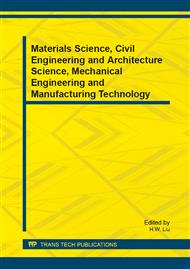[1]
Merriam Webster's Collegiate Dictionary 1266 (11th ed. 2004).
Google Scholar
[2]
Patrick Suppes. Rules of Proportion in Architecture [J]. Midwest Studies in Philosophy, XVI (1991), pp.352-358.
DOI: 10.1111/j.1475-4975.1991.tb00247.x
Google Scholar
[3]
Alberti, Leon Battista. De re aedificatoria (On the art of building in ten books) [M]. (Translated by Joseph Rykwert, Neil Leach and Robert Tavernor) . London: MIT Press (1988).
DOI: 10.2307/990477
Google Scholar
[4]
Ssu-cheng Liang,Lin Shu (ed. ). Chinese Architecture: Art and Artifacts [M]. Beijing: Foreign Language Teaching and Research Press (2011). (in Chinese &English).
Google Scholar
[5]
Charlie Q. L. Xue. Building a Revolution: Chinese Architecture Since 1980 [M]. Hongkong University Press (2006).
Google Scholar
[6]
Qingzhou Wu. Tortoise Culture and Traditional Chinese Architecture [J]. Architectural History and Theory (2008 Academic Conference Papers, the 9th Series). China Academic Journal Electronic Publishing House (2008). (in Chinese).
Google Scholar
[7]
Xiaoxiang Tang. Modern Lingnan Architectural Culture and Aesthetics [M]. Beijing: China Architecture & Building Press (2010). (in Chinese).
Google Scholar
[8]
Lao Tzu. Tao Te Ching. Changchun: Jilin Science and Literature Press, May (2006).
Google Scholar
[9]
Zhuang Tzu. Zhuang Tzu. Beijing: Zhonghua Book Company. Mar(2007).
Google Scholar
[10]
Xu Ping. Feng-shui Models Structured Traditional Beijing Courtyard Houses [J]. Journal of Architectural and Planning Research. 15: 4 (1998), pp.271-282.
Google Scholar
[11]
Xu Ping. Feng-shui: A model for landscape analysis. Unpublished doctoral dissertation, Harvard University, Cambridge, MA (1990).
Google Scholar
[12]
Qijun Wang. Traditional Chinese Building Groups[M]. Beijing: China Electric Power Press (2009). p.113. (in Chinese).
Google Scholar
[13]
Ssu-cheng Liang. Qing Structural Regulations·Introduction [M]. Beijing: China Architecture & Building Press (1981). (in Chinese).
Google Scholar


